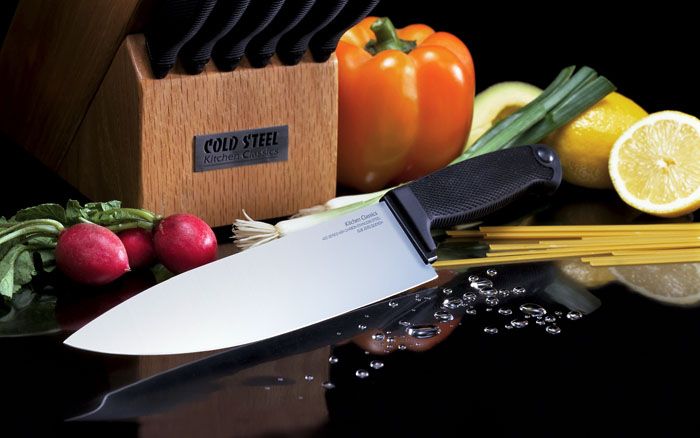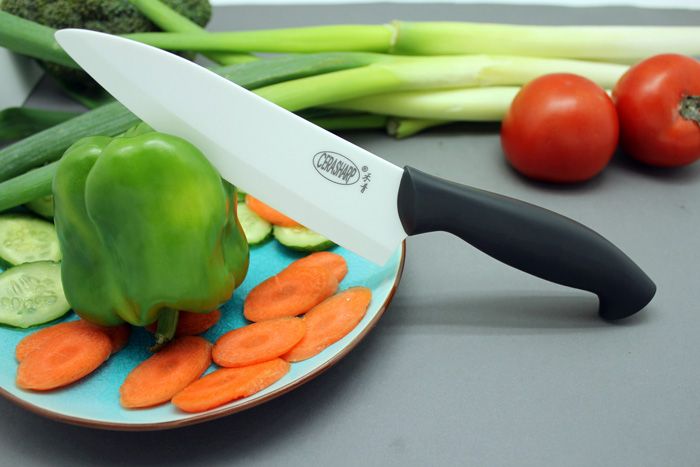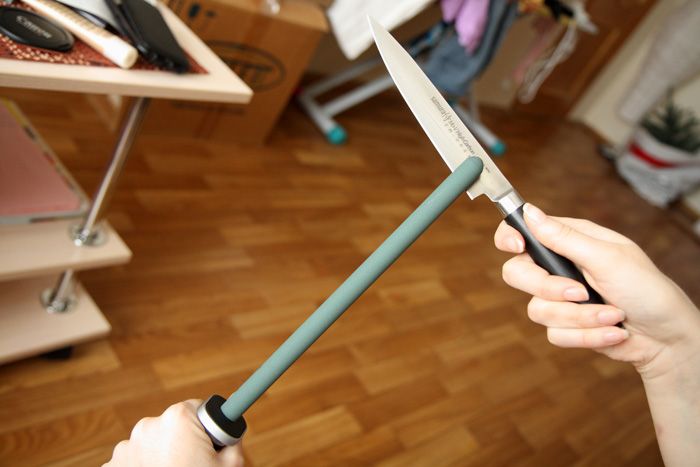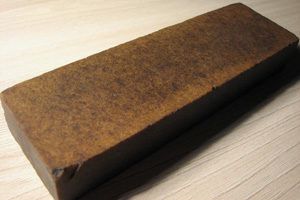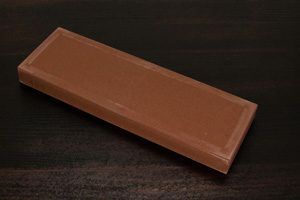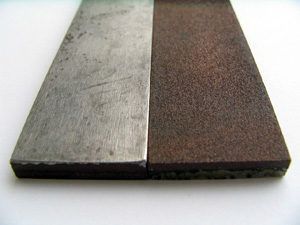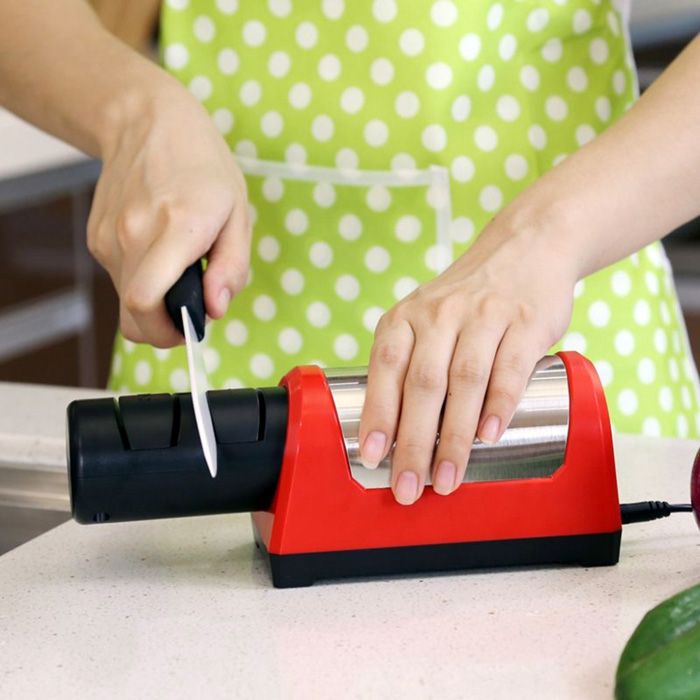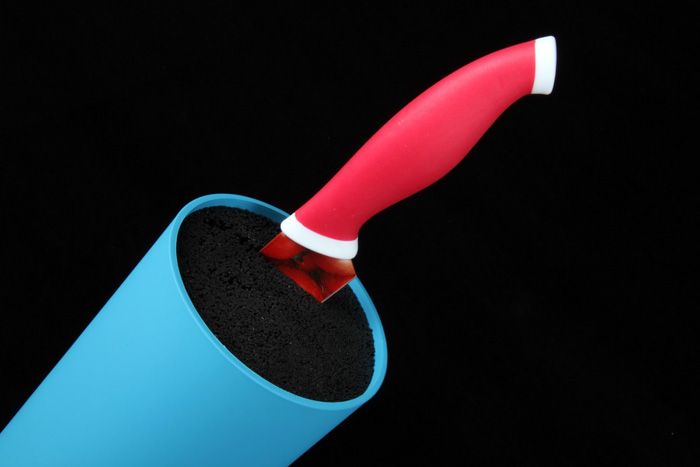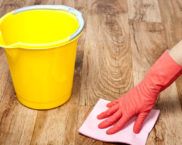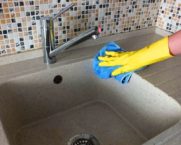Eyes are afraid, hands are doing: how to sharpen a ceramic knife at home
Dull knives in the kitchen are a disaster for the hostess. Cooking turns into a food fight. People say: what a knife, such is the owner. And even if you bought newfangled and sharpest ceramic instruments, sooner or later the day will come when they will require sharpening. In this article from homemaster.techinfus.com/en/ we will talk about how to sharpen a ceramic knife at home. What can be used for this difficult job and is it worth it, in general, to take on it yourself?

The ceramic knife is a handy and practical kitchen tool. It stays sharp for a long time thanks to a special manufacturing technology
The content of the article [Hide]
- 1 Why ceramics are becoming more popular than conventional metal
- 2 Basic rules for sharpening ceramic knives at home
- 3 How to sharpen a ceramic knife at home: from one or two sides
- 4 How can you sharpen a ceramic knife at home: tool options
- 5 How to use and care for your ceramic blade
- 6 Summing up: how to sharpen a ceramic knife at home
Why ceramics are becoming more popular than conventional metal
For thousands of years, the metal blade has had no competition. Long-lasting, strong, sharp, it served a person faithfully in battle and in everyday life. At the end of the last century, the resourceful Japanese proposed an alternative - ceramic knives. At first they were perceived as something exotic. But the quality of these products was so much to the liking of the inhabitants that now such tools can be found in every home.
This kitchen tool is made of zirconium dioxide, a synthetic material. Zirconium powder is pressed and subjected to long-term high-temperature firing. The result is a sharp blade with excellent characteristics:
In short, such a tool is very useful in the kitchen. But it should be handled with great care. Ceramic knives are quite fragile, they break and break. With excessive force or hitting a bone, the blade breaks off.
Before starting this work, carefully study how you can sharpen ceramic knives at home.
Basic rules for sharpening ceramic knives at home
If the ceramic blade has begun to be capricious and is no longer so confident in handling vegetables and bread, it's time to think about sharpening. You can, of course, go to a specialized workshop to an experienced craftsman. His services will not be cheap, be prepared for this. It is for this reason that many are interested in how you can sharpen a ceramic knife with your own hands at home. It must be remembered that not every sharpening tool is suitable for ceramics. A regular metal knife sharpener is not suitable for brittle zirconium. It is best to think about dressing the blades at the time of purchase and purchase special devices in the same store.
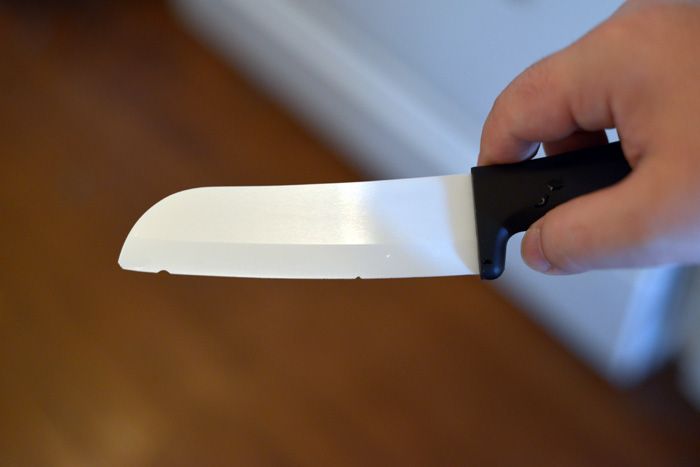
Keep in mind that a ceramic tool is sharpened differently than ordinary metal, it requires skill and some knowledge
And now about what and how you can sharpen a ceramic knife:
How to sharpen a ceramic knife at home: from one or two sides
Start by taking a close look at the knife. First of all, you need to determine how the blade was originally made: sharpened on one or both sides? One-sided sharpening is more common in Japanese and Korean products. European manufacturers usually use a wedge shape.
If you start sharpening a blade with a one-sided bevel on both sides, you will hopelessly ruin it. You should carefully grind off the desired side until you get a burr on the edge, and then carefully remove it with a couple of wires through the abrasive.
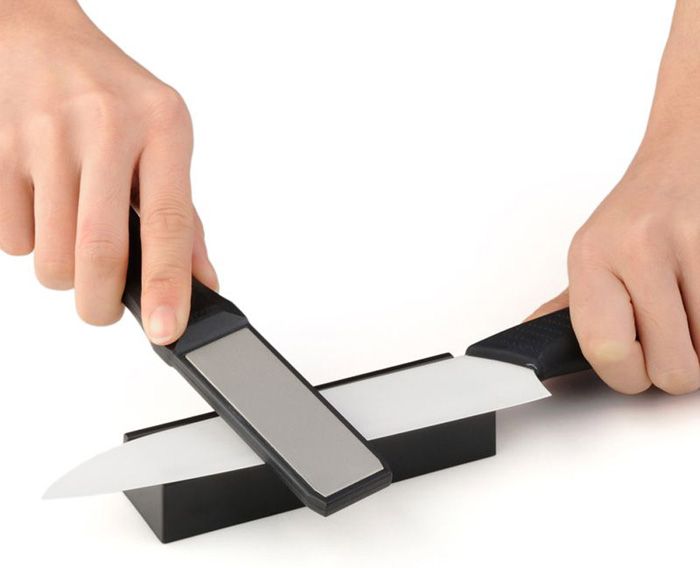
Wedge-shaped blades are machined on both sides until a burr is formed, and then final grinding is carried out using a fine-grained material
How can you sharpen a ceramic knife at home: tool options
Not every tool will cope with the incredibly hard surfaces of hardened ceramics. To process such a material, diamond dusting will be required, a conventional grinding tool will be useless. The work is divided into three steps:
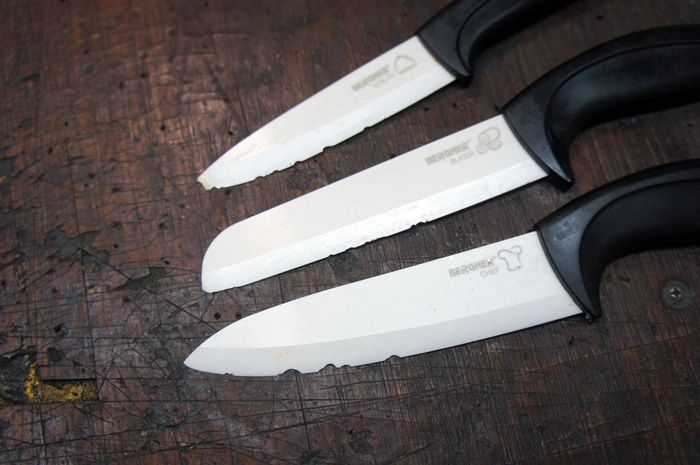
If you neglect the polishing of the tool, you can lose the knife in the next couple of days - it will simply crumble
How to sharpen ceramic knives at home with a specialized musat
Musat is a handy tool for dressing knives. It allows you to quickly straighten the cutting edge. To use it, you need a certain skill: the tip of the musat is pressed against the table on a napkin and then it is drawn across its surface with a knife at a certain angle, changing sides every 4 wires.
Video: how to sharpen a knife at home

Stones and whetstones: which ones to choose
The use of musata requires skill. It is much easier to work with a whetstone or stone. But here, too, it must be remembered that the grain on the stone is different, and it also interacts with ceramics in different ways:
You will find that this material has a fairly wide range. The stones are different and have different origins. Here are their main characteristics:
Mechanical sharpeners for ceramic knives
Any manual sharpening takes time, perseverance and patience. To speed up the process, many housewives use various kinds of mechanical devices. Conveniently, the angle of the blade does not need to be selected manually - it is fixed by the device. Usually the knife is inserted vertically.
Cheap kitchen sharpeners are not suitable for ceramics. Use them a couple of times - and feel free to throw the knife away. For such a delicate work, you will have to look for a diamond-coated product.
Electric sharpening tool
Electric models are not cheap, but due to their complex design they guarantee high-quality sharpening. You can buy such a tool in specialized stores at a price of 4,000 rubles.
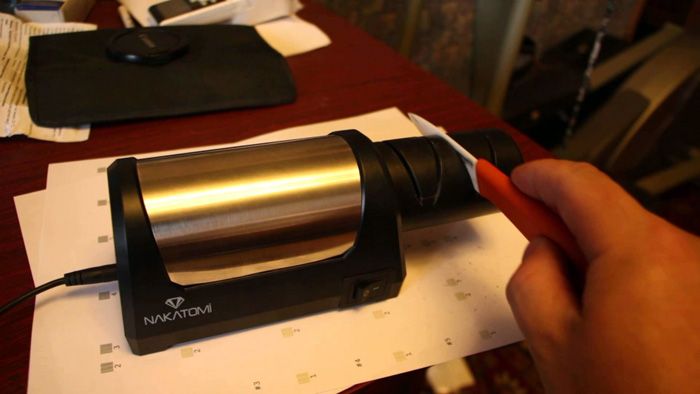
The electric sharpener design includes diamond-coated discs that are positioned at an ideal angle for dressing the blade. It's hard to ruin a knife with such a tool
The device does its job quickly and efficiently, you do not risk accidentally cutting yourself. In short, this is the ideal of all the options listed above.
Diamond paste: long but perfect
Grinding a blade with diamond paste is a very time-consuming process. The paste is applied to a leather belt and the surface is sanded for a very long time until the desired result is achieved.
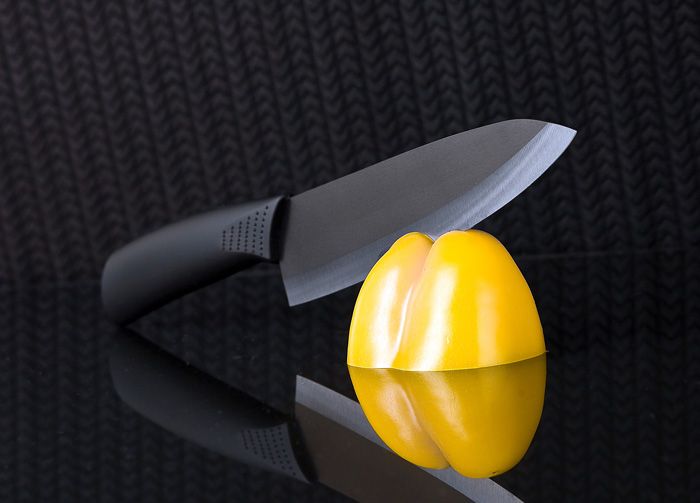
But it should be noted that this time-consuming method has an extraordinary result that no stones and machines can achieve.
Grinding machines: is it worth using them for sharpening ceramics
If you are comfortable using a grinding wheel, you can try sharpening a ceramic knife on it using attachments with different grit sizes. But this is not an easy task, and the beating of the abrasive is more likely to ruin the blade.
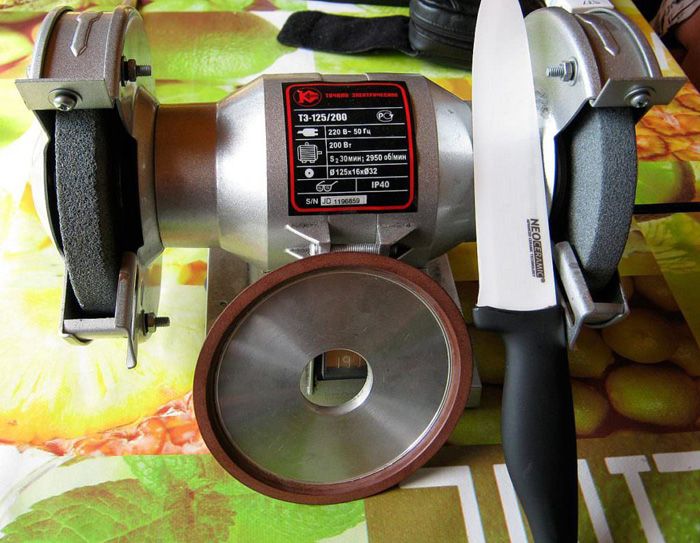
If you do decide, watch the tilt of the blade up to 30 ° degrees and take your time, this tool does not tolerate haste and negligence
How to use and care for your ceramic blade
- Do not use this knife to cut meat with bones, frozen food and hard cheese.
- Do not drop the knife onto the tiles; place it carefully in the sink.
- Keep the blade away from fire, it may get hot enough to melt the handle.
- Do not use these knives to crush garlic or open jars.
- Purchase a plastic or wooden chopping board for ceramic tools. Do not use boards made of glass, stone, metal, or ceramic.
- Do not try to bend the blade - it will break.
- Do not place ceramic utensils in the dishwasher. It should only be washed by hand with a mild detergent.
- If the knife turns a little yellow, wash it in mild bleach.
Summing up: how to sharpen a ceramic knife at home
So, sharpening ceramics with your own hands is, in principle, possible. Choose one of the listed methods and get down to work carefully. Remember, haste can work against you. Remember to maintain the correct angle when sharpening. Do not repeat the procedure with your ceramic instrument too often: for high-quality sharpening, this should only be done once or twice a year.
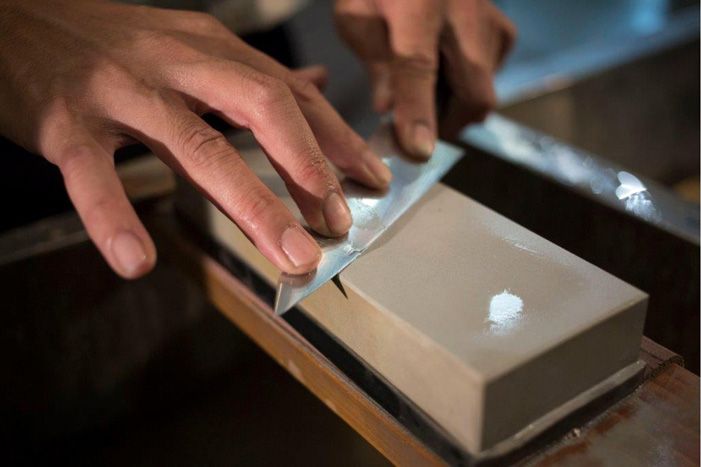
But if you are not confident in your abilities, and your knives are an expensive and high-quality tool, it is better to contact the professionals!
If you have a similar experience and advice for our readers, write about it in the comments!



